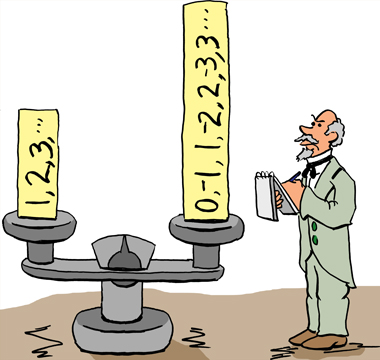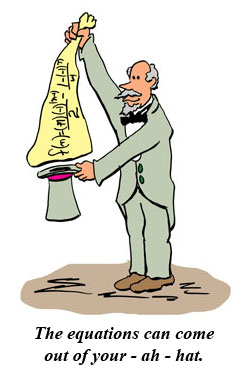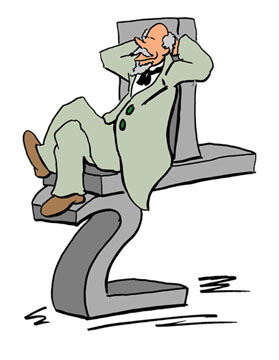|
|
|
A Most Merry and Illustrated Proof of Cantor's Theorem on the Countability of Integers
(Concise Version)
(© 2012, Charles F. Cooper)

George said they both weighed the same.
This is a brief (or at more brief than the one posted on the CooperToons Department of Education webpage) proof that the number of counting numbers (1, 2, 3, 4, ... ) is the same as the number of integers ( ..., -3, -2, -1, 0, 1, 2, 3, ... ). The proof avoids any prerequisites other than elementary algebra and a knowledge of the basics of proof by induction. If the reader is not familiar with proof by induction or would like a refresher, visit the more detailed proof by clicking here.

Disclaimer: Although CooperToons believes the proof given below is complete and correct, he can accept no responsibility if it does not pass muster of a teacher who had something else in mind.
Proof Outline
The proof is based on the ability to arrange the counting numbers in a definite sequence. Although the figure below is not a proof, it illustrates the arrangement that we will define mathematically and prove it works for all counting numbers and integers.
1 | 0 | |
2 | -1 | |
| 3 | 1 | |
4 | -2 | |
5 | 2 | |
6 | -3 | |
7 | 3 | |
. |
This theorem was first proven by Georg Cantor (pronounced "GAY-org" but the English equivalent "George" is acceptable for our purposes) though not exactly as shown here. The proof by induction will require a demonstration that there is a function, f, whose domain is the counting numbers and which maps the counting numbers to the integers. The function must produce the alternating pattern above. It must be bijective, that is each counting number, n, is paired with a unique integer.
First the properties of the function will be stated. Next, a single function will be proposed that produces the alternating pattern required. Then the function will be simplified by dividing it into separate equations that work for odd and even number separately. The odd counting numbers will produce zero and the positive integers, and the even counting number will produce negative integers. This separation of the function will simplify the induction part of the proof.
1. If n = 1, then f(n) = 0. Next as we move to successive odd counting numbers, the value of the f(n) increases by one. In other words, for any odd number, n, then
f(n+2) = f(n) + 1
Or alternatively
f(n+2) - f(n) = 1
This insures that the odd counting numbers produce zero and all positive integers without repetition.
If n = 2, then f(2) = -1. Then as we move to the next even counting number the value of the function decreases by one.
Then we know that
f(n+2) = f(n) - 1
or its equivalent
f(n+2) - f(n) = -1
is true.
So all even counting numbers will generate all the negative integers.
Because each successive counting number maps either to zero or a counting number to a unique integer, the function pairs every counting number to a unique integer. Retranslated into plain English, this means there are as many counting numbers as integers.
Specifically, the proof will proceed as follows.
1. We will propose a function that fulfills the above requirements for some specific values of the counting numbers beginning with n = 1.
2. Next we will simplify the function by separating it into two equations, one for odd counting numbers and the other for even numbers.
Finally we will prove that if f(n) maps a counting number to a positive or negative integer respectively, then f(n + 2) is the next positive or negative integer, respectively. This will insure that if the general function, f(n), is either an positive or negative integer for a counting number n, then the value of f(n + 1), will be of the proper alternating pattern required to generate all integers.
The Final Function

The proposed function is:
![f(n) = n(-1)^(n-1)/2-(1-[-1]^n/4](function1_72dpi.jpg)
This formula correctly generates the first integers required when n = 1, 2, 3.
That is, if n = 1, then
![f(n) = n(-1)^(n-1)/2+(1-[-1]^n/4](function2_72dpi.jpg)
And if n = 2,
![f(n) = n(-1)^(n-1)/2+(1-[-1]^n/4](function3_72dpi.jpg)
For n = 3
![f(n) = n(-1)^(n-1)/2+(1-[-1]^n/4](function4_72dpi.jpg)
For induction, only the relations between n = 1,2,3 and the integers, 0, -1, and 1 are needed for the first step. But if you keep this up for a few more numbers, you find the correct pairing continues.
|
f(1) |
= |
0 |
|
f(2) |
= |
-1 |
|
f(3) |
= |
1 |
|
f(4) |
= |
-2 |
|
f(5) |
= |
2 |
|
f(6) |
= |
-3 |
|
f(7) |
= |
3 |
So the formula does set up the correct one-to-one correspondence with the lowest counting numbers and the appropriate integers.
The equation can now be separated into two functions specifically for the odd or even numbers.
Because by the law of exponents if n is odd
(-1)(n-1) = 1 and (-1)n =-1
Therefore
![f(n) = n(-1)^(n-1)/2-(1-[-1]^n/4](function5_72dpi.jpg)
On the other hand if n is even
(-1)(n-1) = -1 and (-1)n =1
and
![f(n) = n(-1)^(n-1)/2-(1-[-1]^n/4](function6_72dpi.jpg)
The counting numbers and their relationships to the positive and negative integers can now be demonstrated.
Since we have already shown the equation works for some specific values of counting numbers, we only have to prove the inductive part of the proof.
That is, for odd numbers we have to show
f(n + 2) - f(n) = 1
And sure enough:
![f(n) = n(-1)^(n-1)/2-(1-[-1]^n/4](function7_72dpi.jpg)
For even numbers we have to prove.
f(n + 2) - f(n) = -1
and indeed:
![f(n) = n(-1)^(n-1)/2-(1-[-1]^n/4](function8_72dpi.jpg)
Conclusions
So what have we shown? Well, exactly what we said we needed.
The function
![f(n) = n(-1)^(n-1)/2-(1-[-1]^n/4](function1_72dpi.jpg)
1. Has a value 0 if n = 1 and increases sequentially by 1 for all odd numbers.
2. Has a value of -1 if n = 2. It decreases sequentially by 1 for each even number.
Therefore f(n) will generate all integers if n is restricted to the counting numbers. This proves there is a 1:1 correspondence between the integers and counting numbers. The two sets are therefore the same size, or as George put it, they share the same cardinality. The size or cardinality of a countable infinity, George identified as the first transfinite cardinal number, aleph-null or aleph-null or So there really are as many integers as counting numbers. So George was right after all. How about that? Addendum Of course, George didn't stop here. He not only used his famous diagonal argument to prove that the number of real numbers was greater than the counting numbers, but he also - and in someways this was even more amazing - showed that the number of rational numbers - that is, the fractions - were the same as the number of counting numbers. This latter conclusion is by no means intuitive since you can pick two rationals and squeeze any number of other rationals between them (something you cannot do for counting numbers or integers). The proof, though, is more involved, but is pretty slick and still follows from the rules of induction and simple algebra. But that, perhaps, will be another story. .
.
